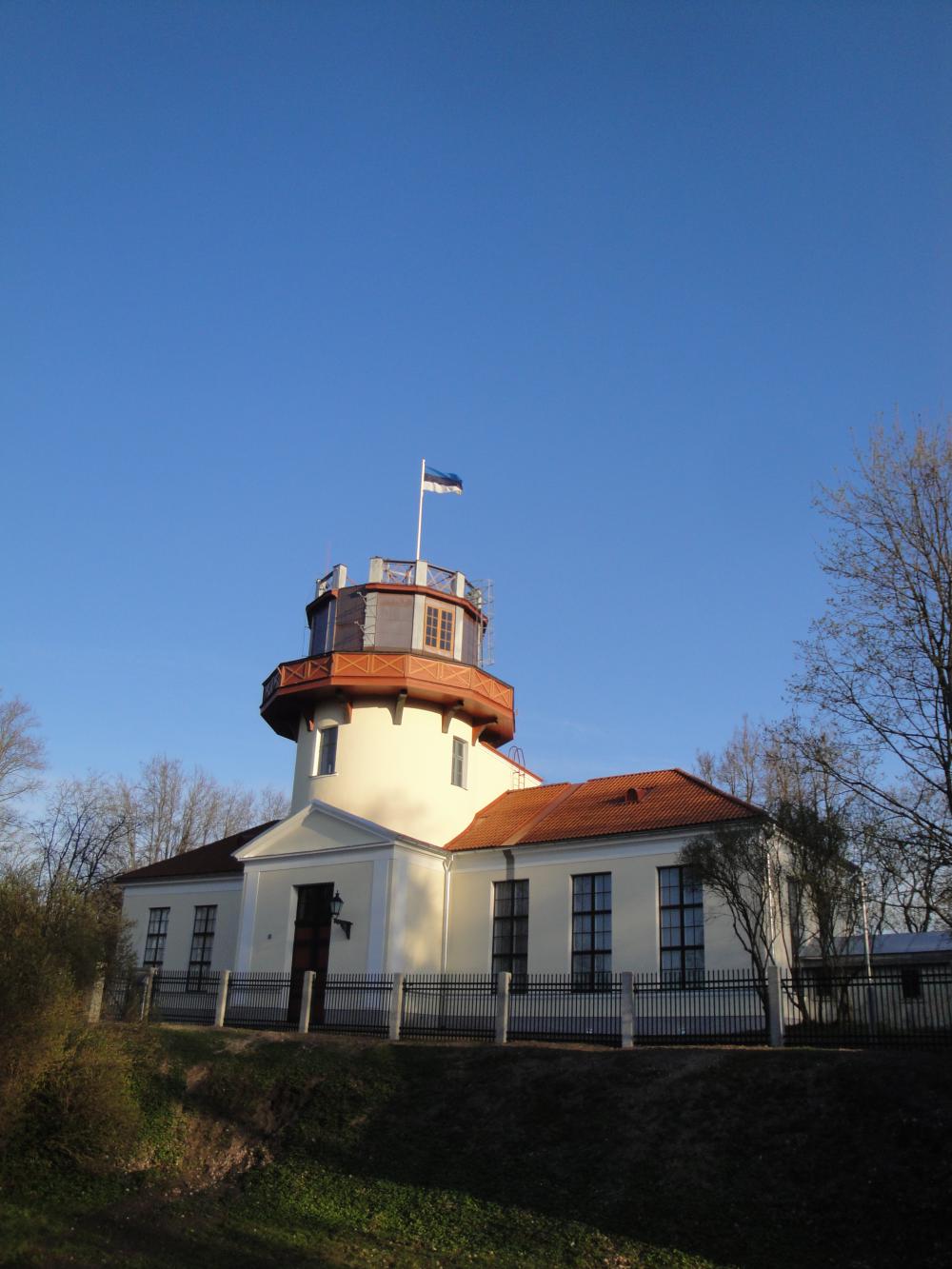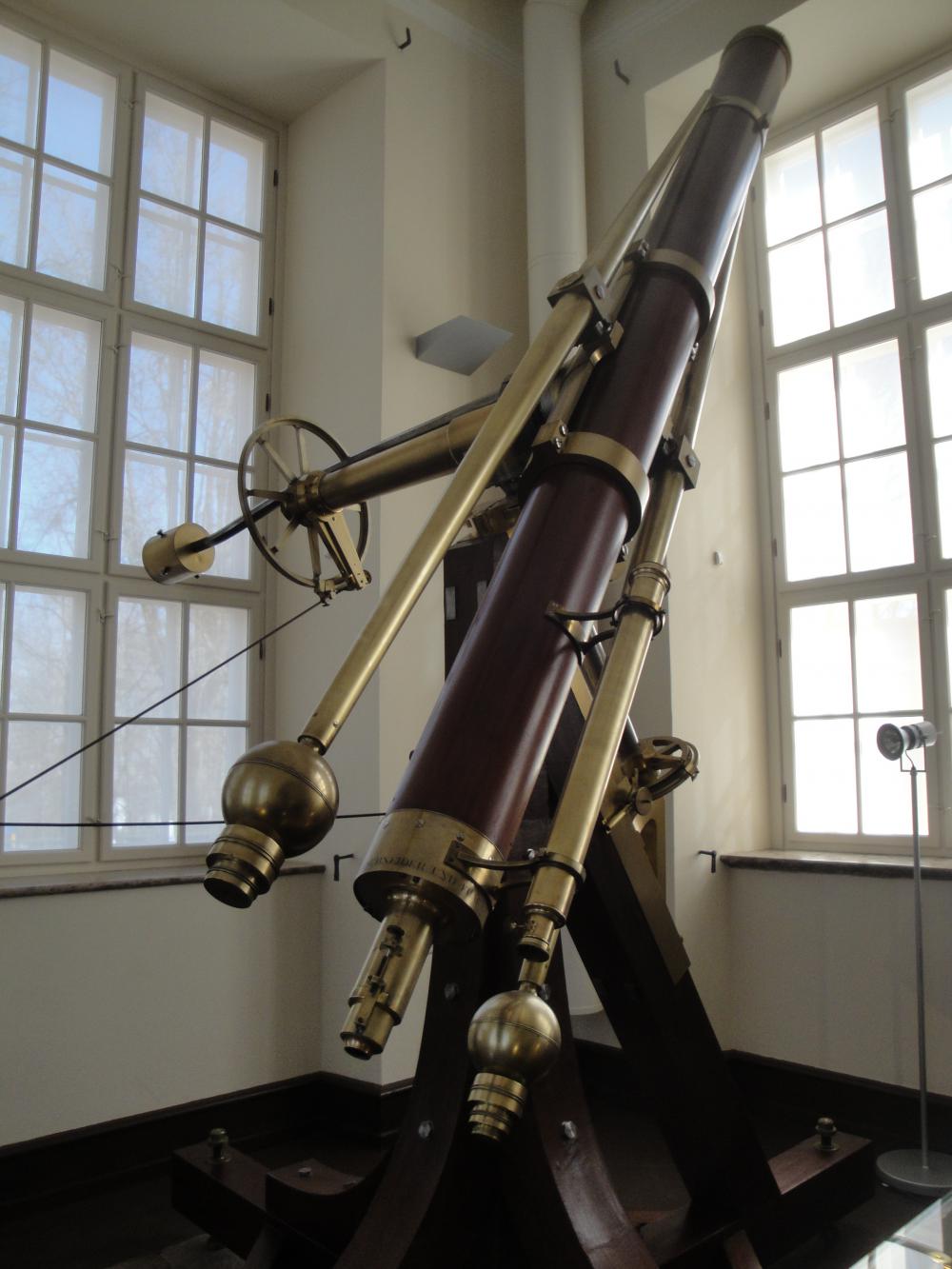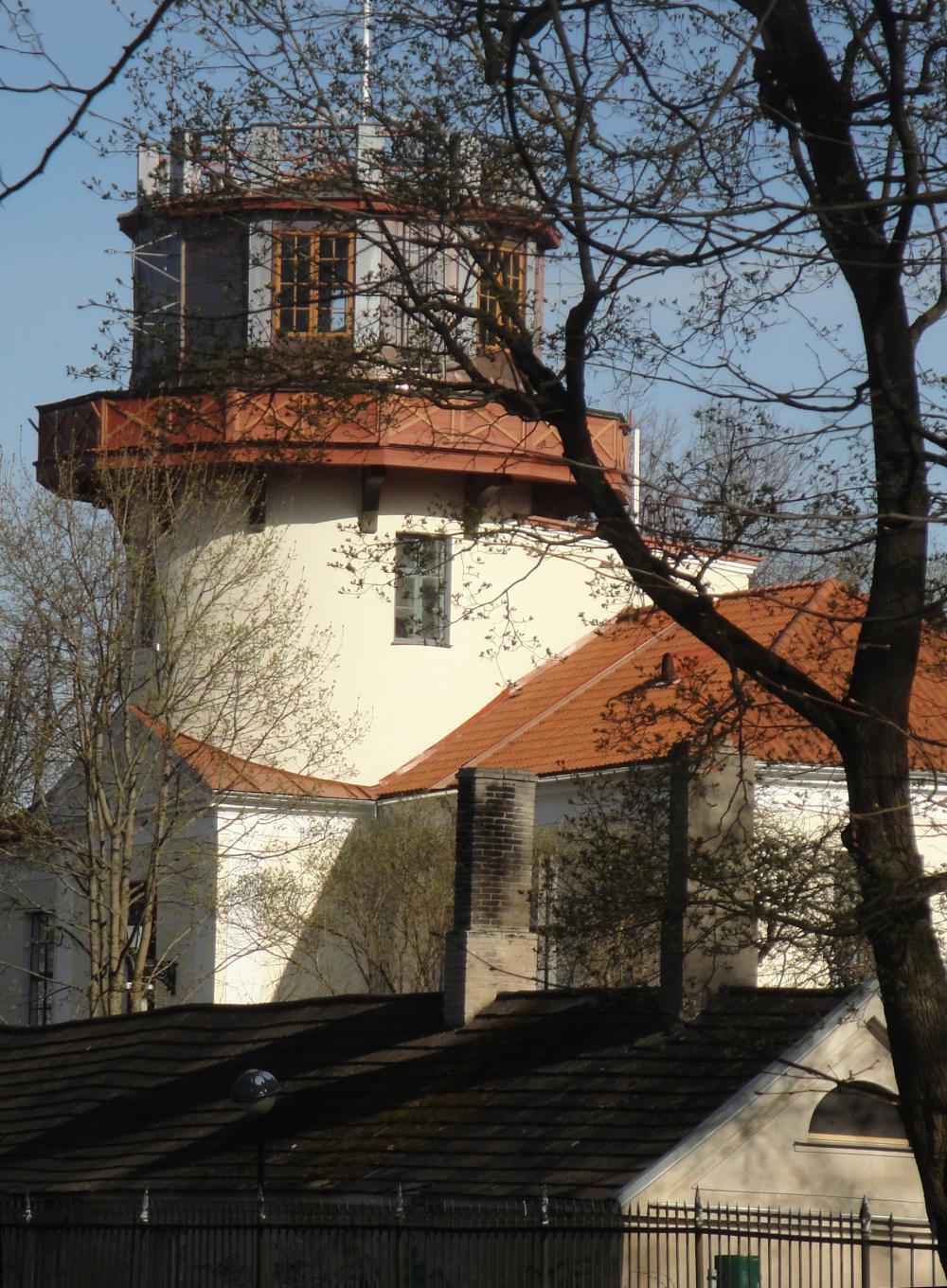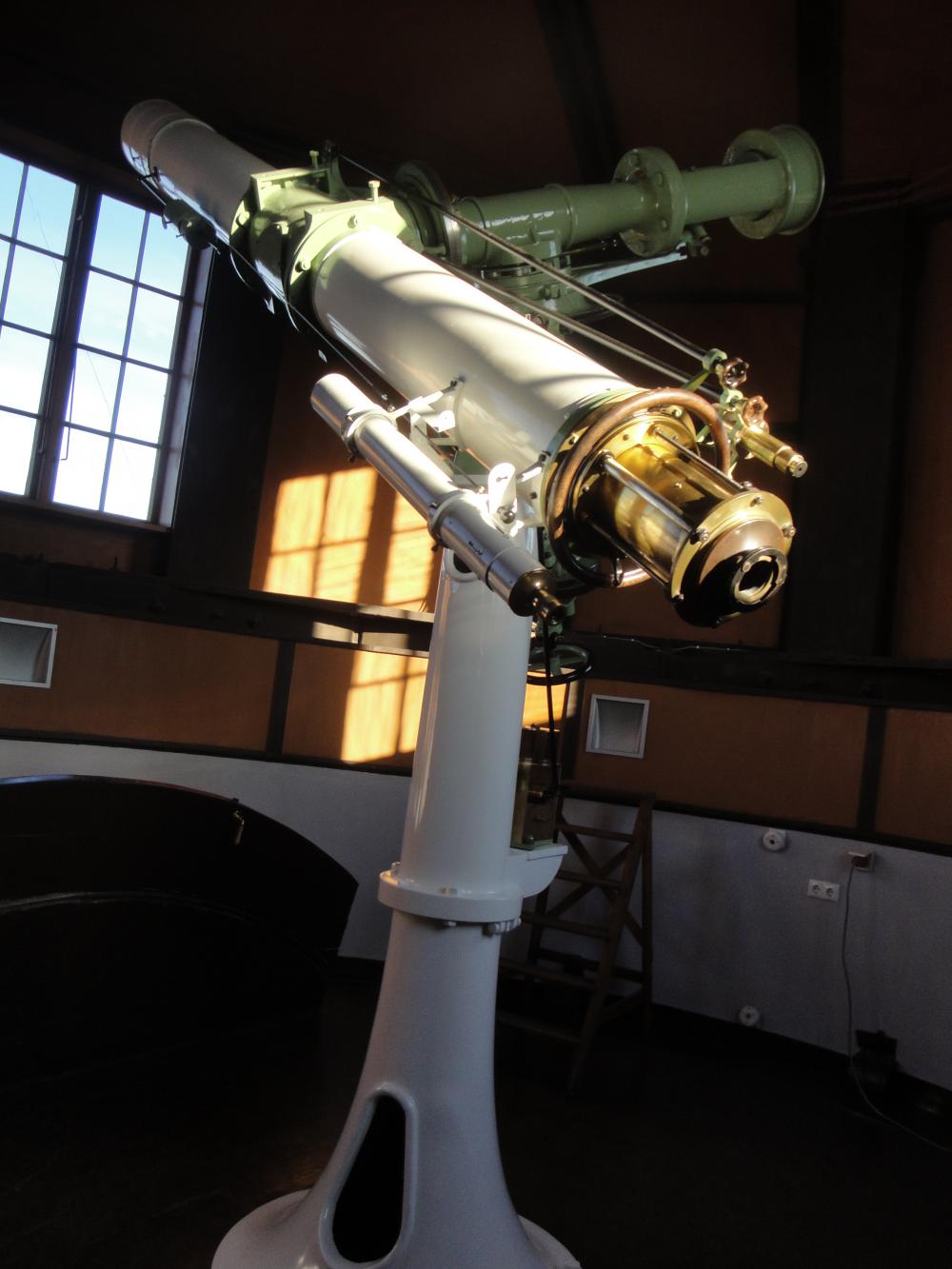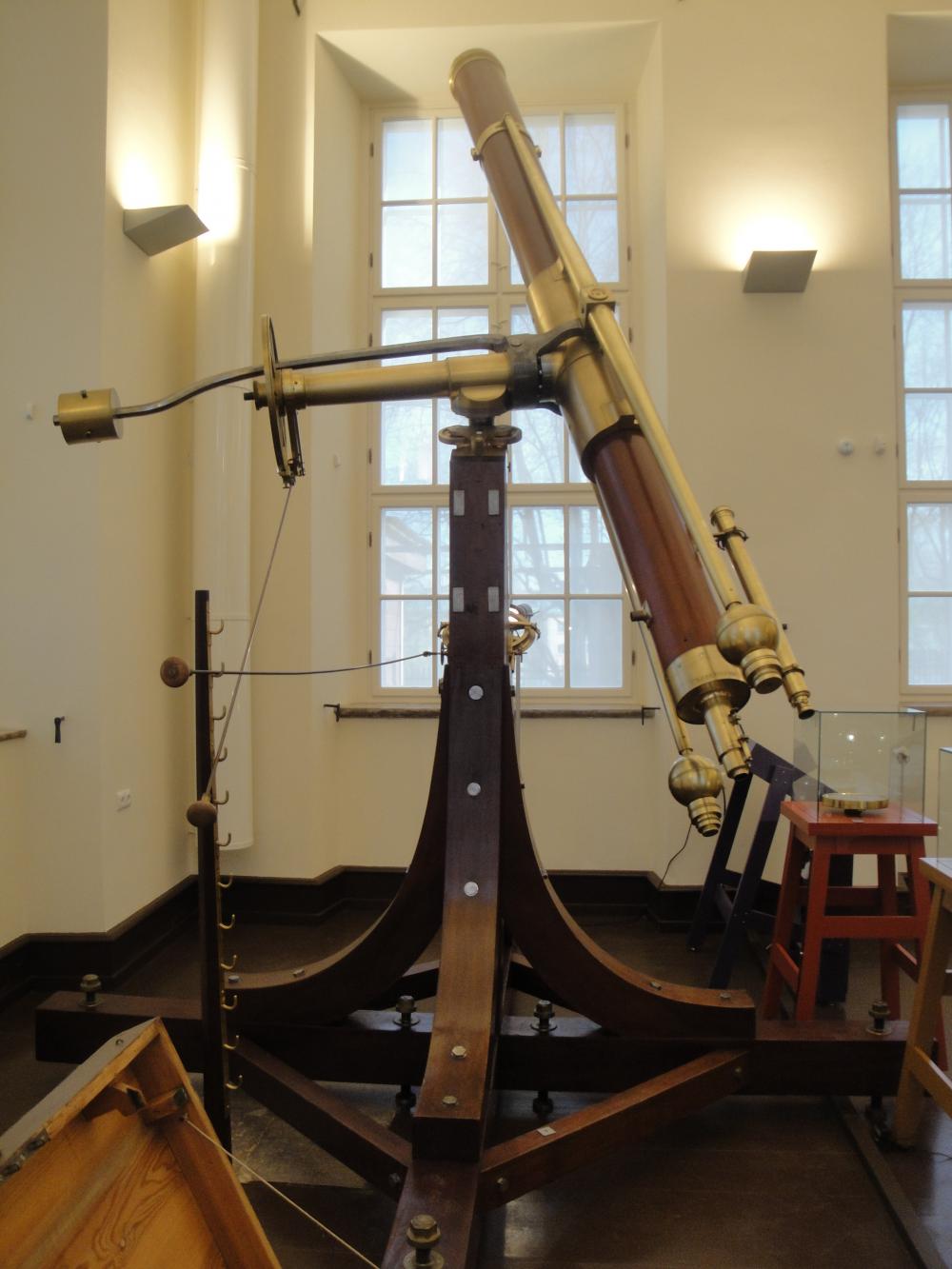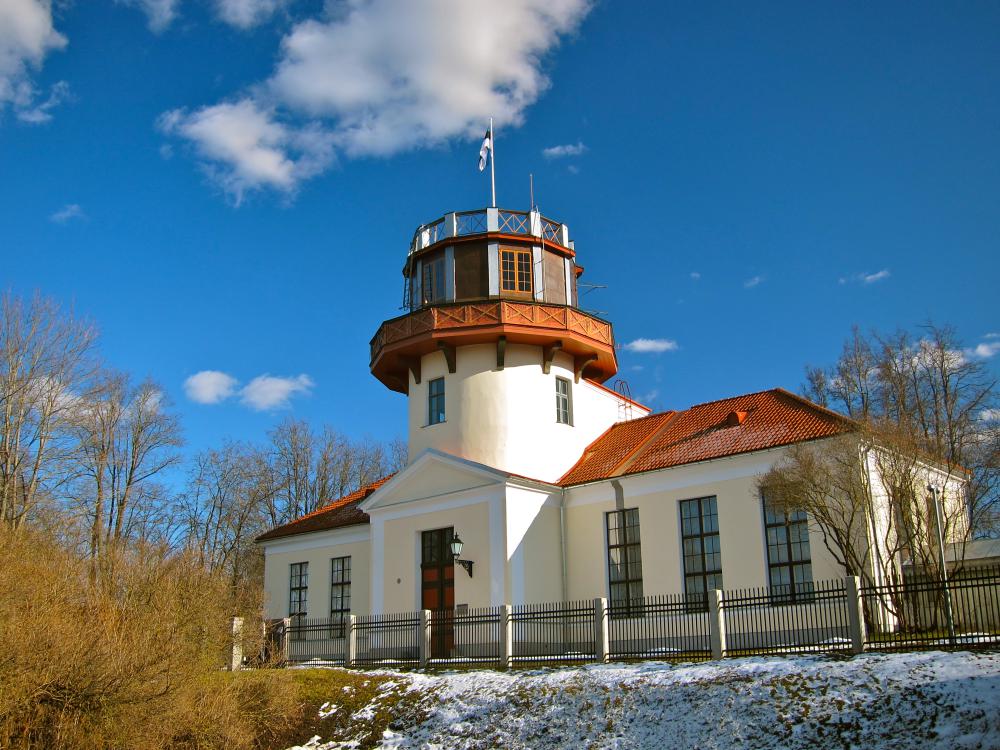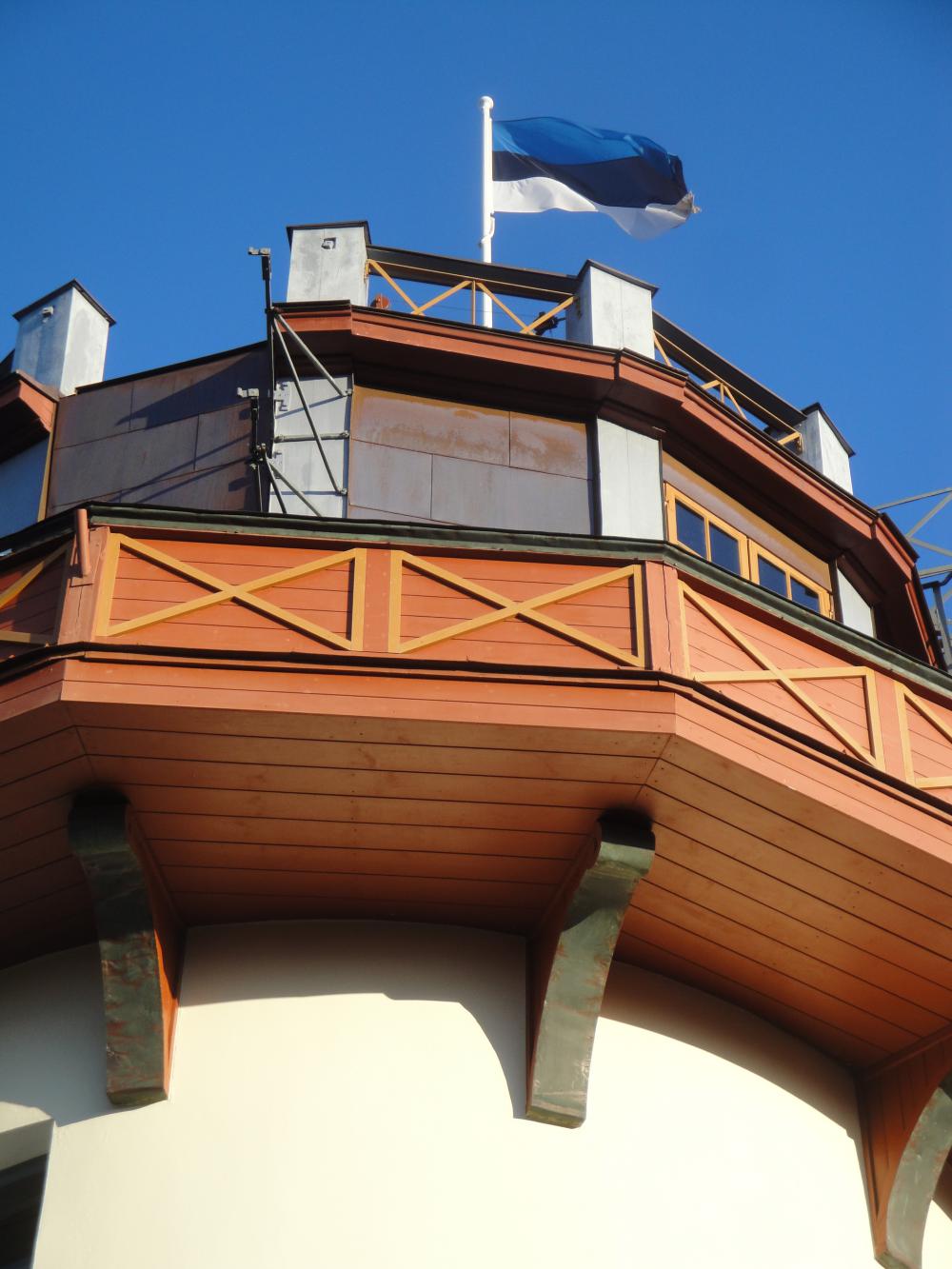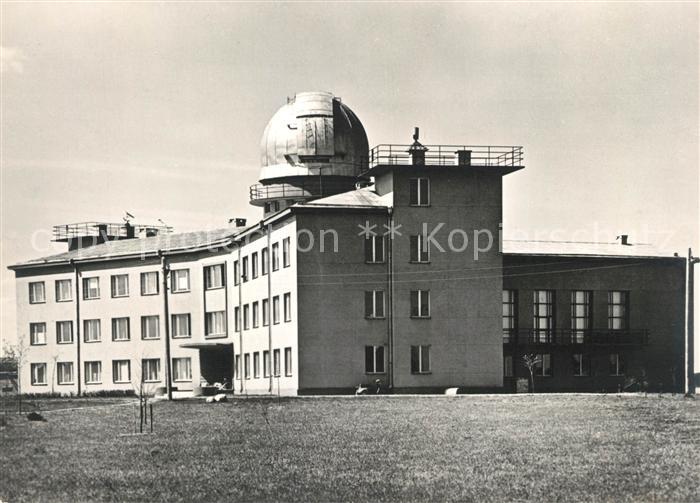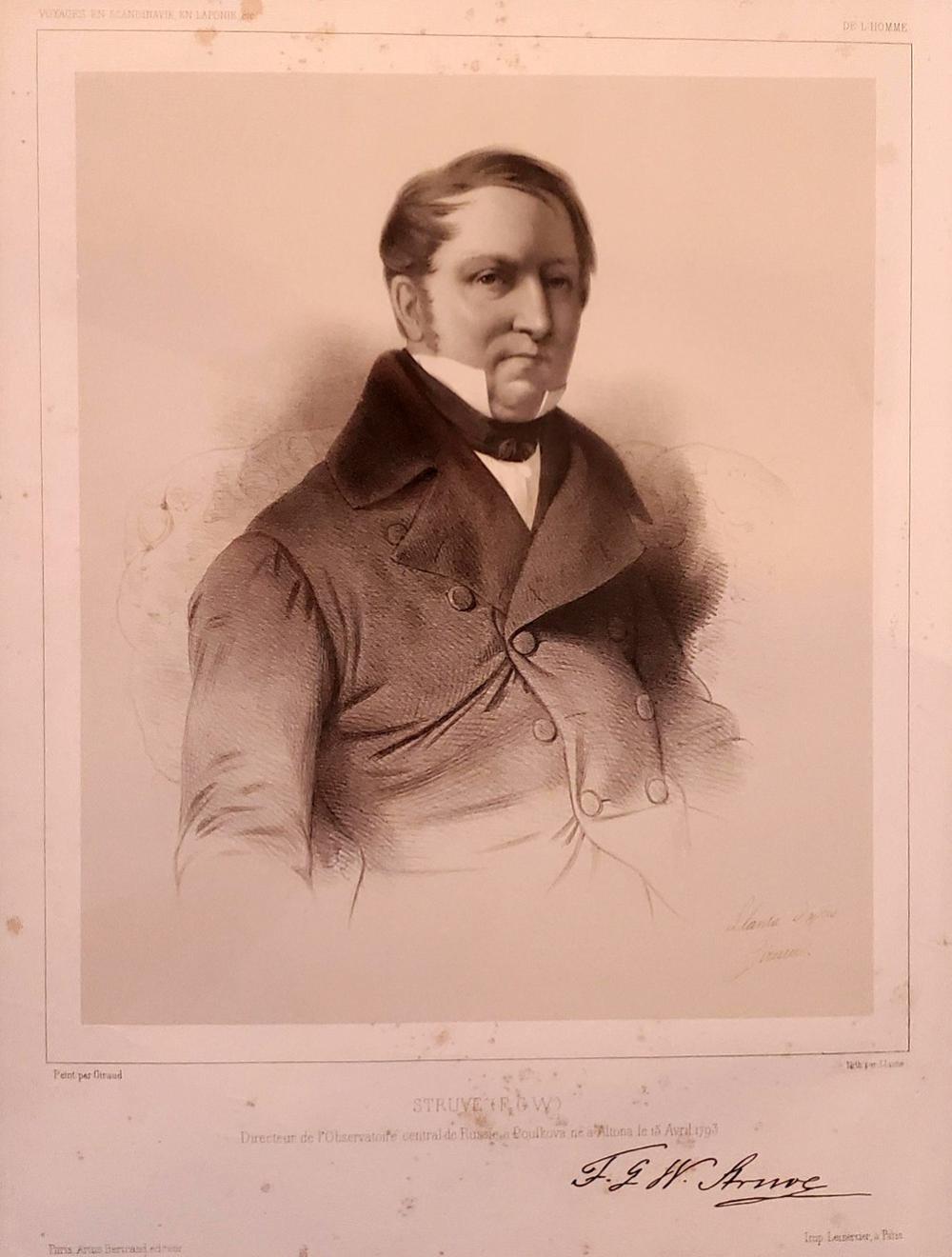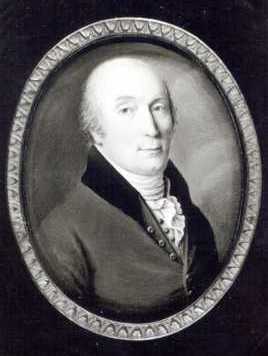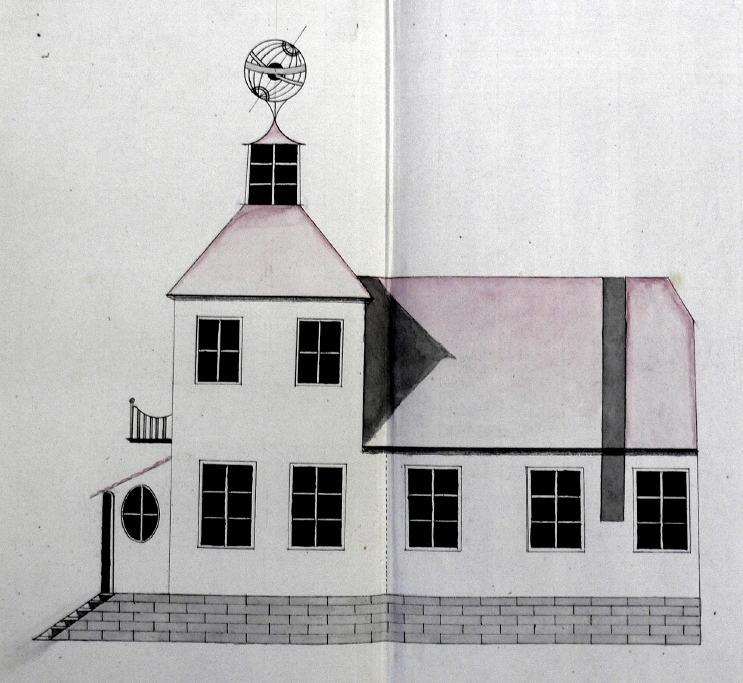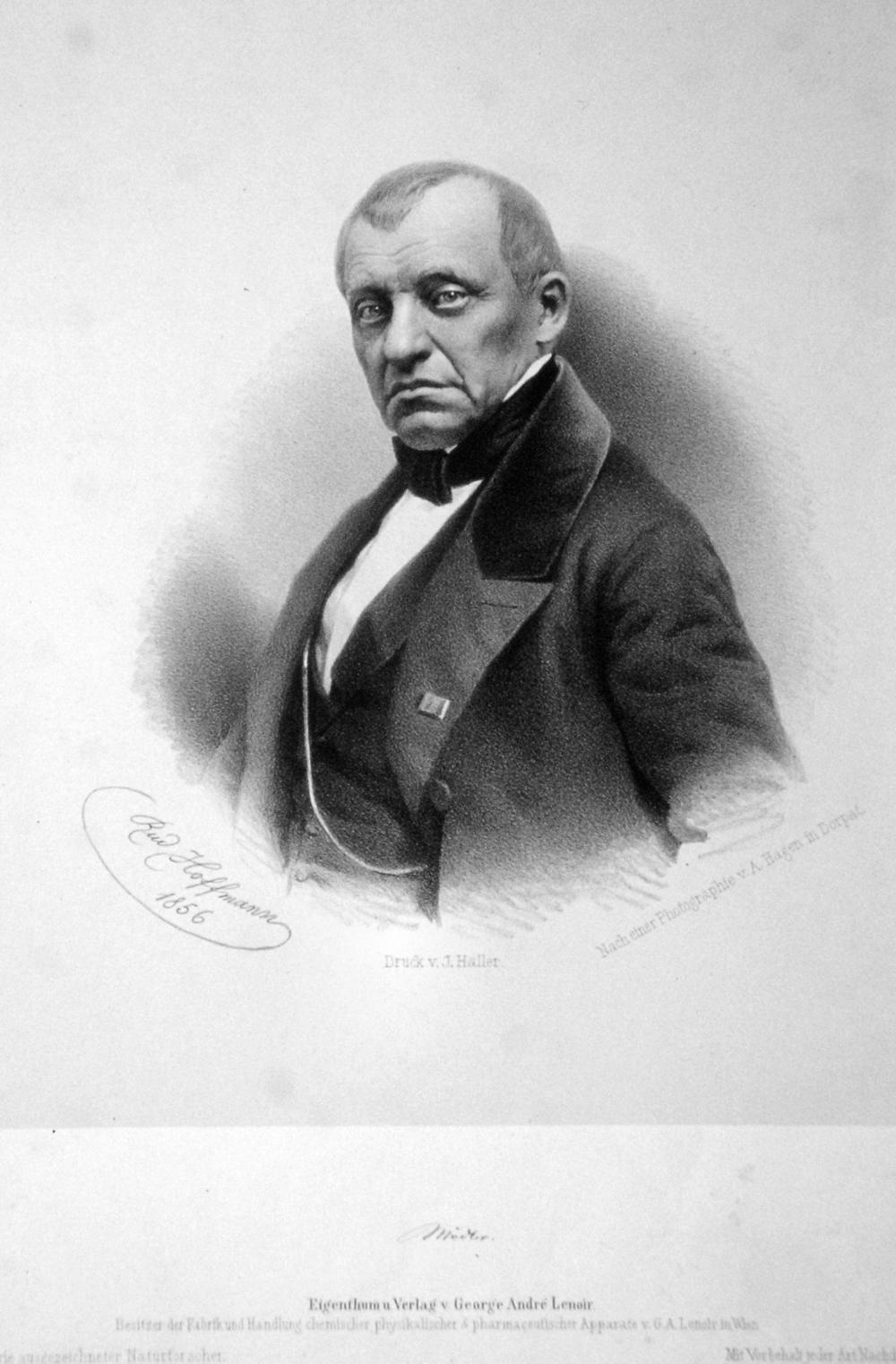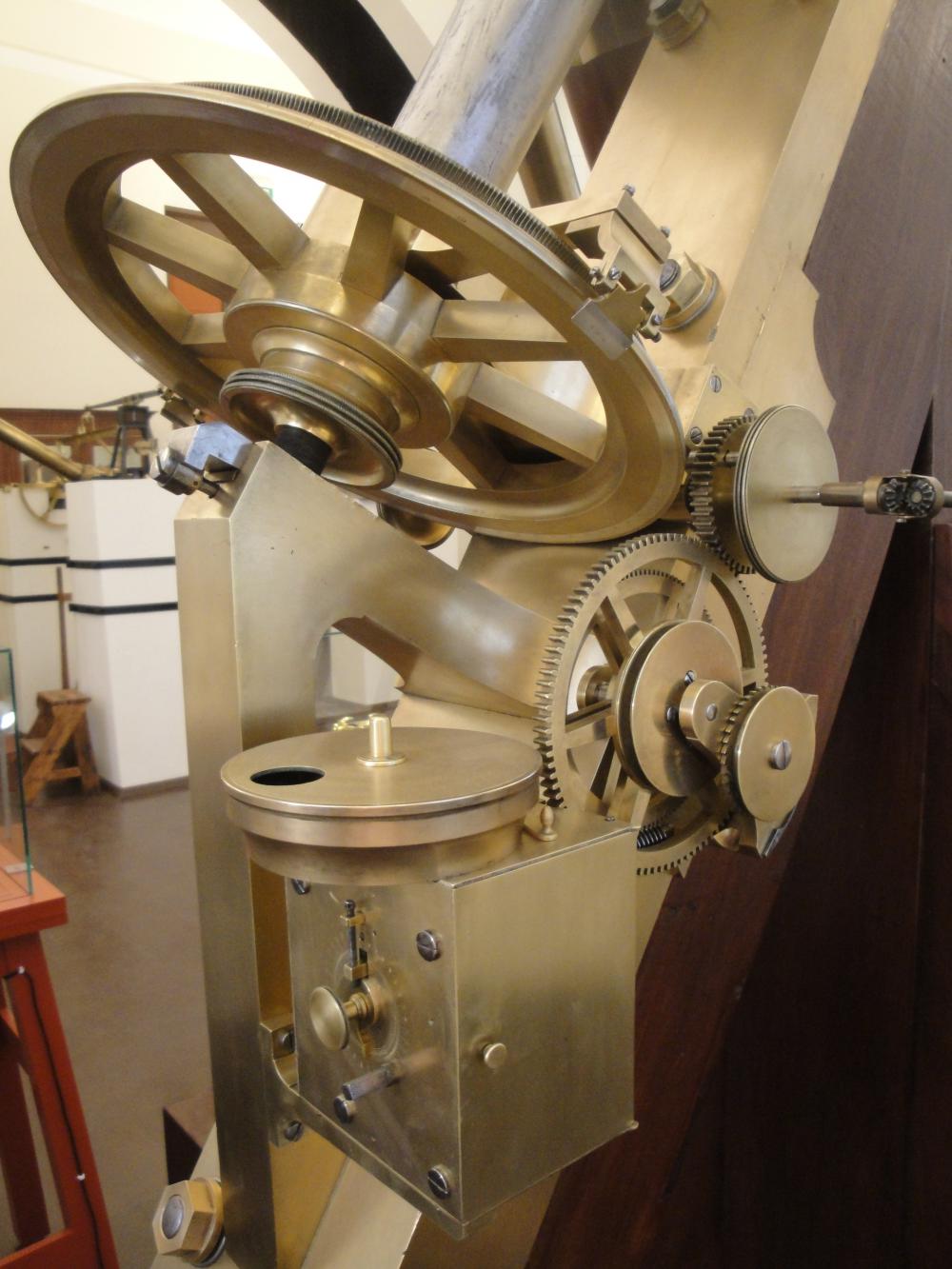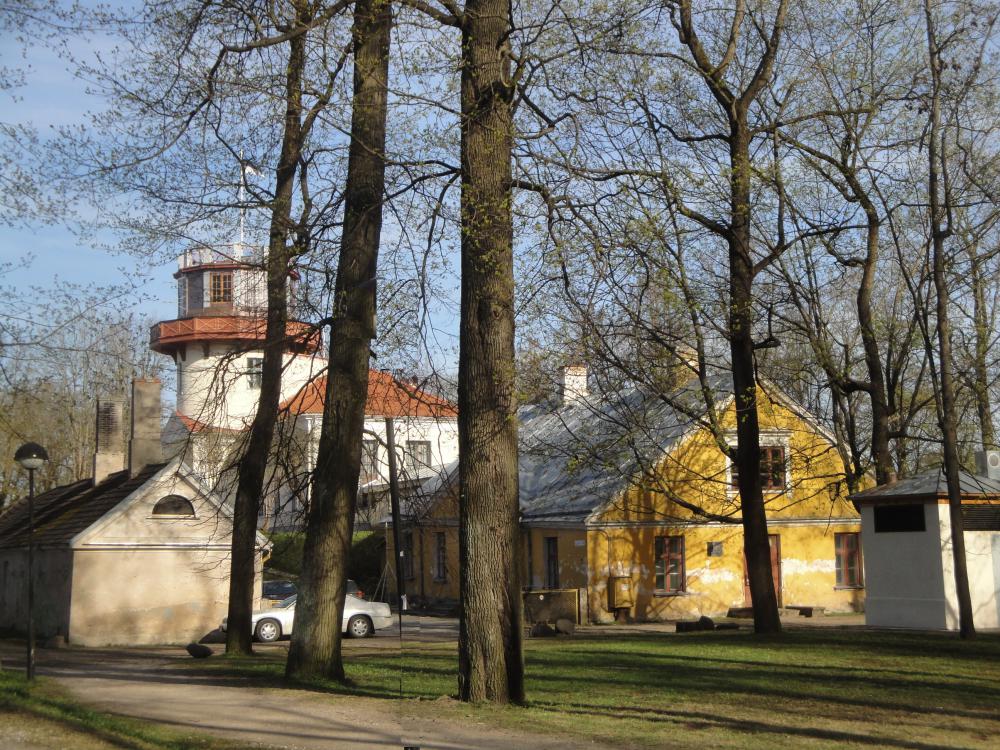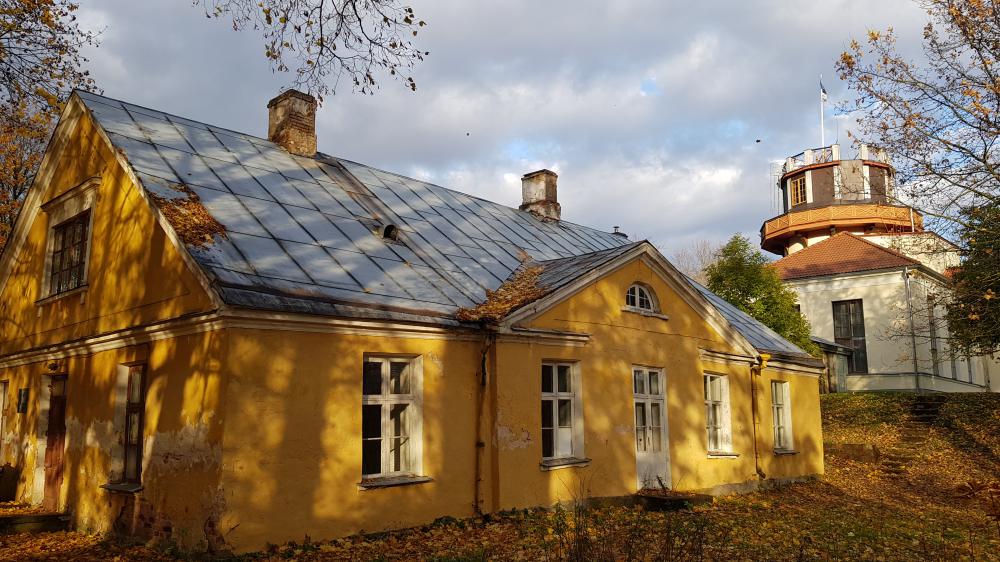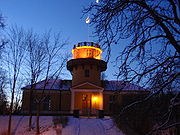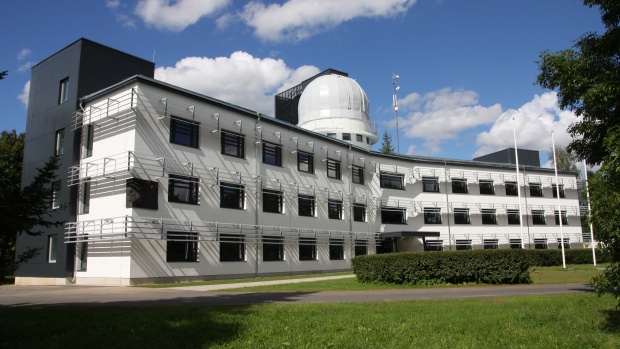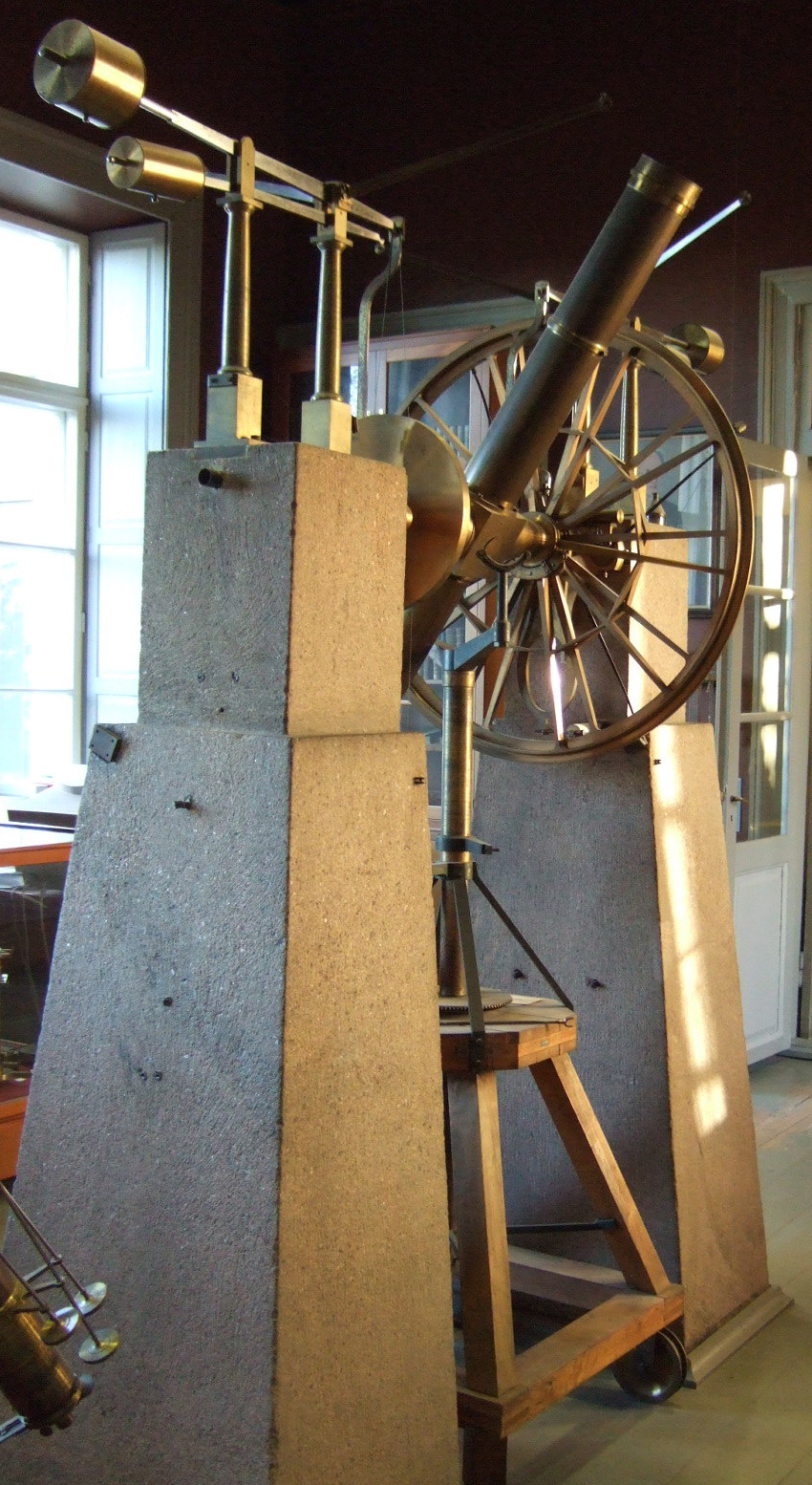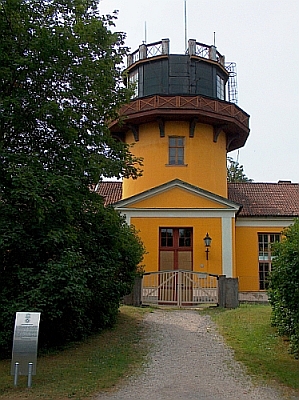
Category of Astronomical Heritage: tangible immovable
Tartu Observatory, Estonia

Description
Geographical position
Old Tartu Observatory (German "Dorpat, Livland"/Livonia until 1893,
Russian "Derpt" until 1893, "Jurjew" or "Jurjewskaja observatorija" 1893 to 1917), Tartu, Estonia,
New Tartu Observatory: 1963 new building in Töravere
(new: 58°15’55’’ N, 26°27’59’’ E)
Location
Latitude 58°22’47’’ N, Longitude 26°43’18’’ E, Elevation 48m above mean sea level.
IAU observatory code
075
Description of (scientific/cultural/natural) heritage
Fig. 1. Tartu Observatory (1810), Dorpat Observatory until 1919 (Photo: Gudrun Wolfschmidt)
At the beginning of the 19th century, the rectangular observatory with a central dome developed as a typical architectural design alongside the Greek cross-shaped structure (with arms of equal length). An important early example is the Dorpat/Tartu Observatory, which combines both characteristics.
Friedrich Georg Wilhelm [von] Struve (1793--1864) was born in Altona (until 1864 Denmark, today Hamburg), and in 1808, he decided to flee from Altona in order to avoid conscription to the Napoleon's army. He studied philology, and mathematics and astronomy in Dorpat University, and in 1813, he got his PhD (De geographicae positione speculae Dorpatensis) and became astronomer-observer and extraordinary professor of mathematics and astronomy, in 1820 full (ordinary) professor at the University of Dorpat.
In 1815 and 1816, Struve travelled in Germany and met the leading astronomers and mathematicians: H. W. M. Olbers, C. F. Gauss, F. W. Bessel, and others, and instrument makers like Johann Georg Repsold, Joseph Fraunhofer).
The result of the trip was that in 1817 the meridian circle was ordered from the Reichenbach & Ertel workshop in Munich.
In 1820, he took over the office of the director of the Dorpat Observatory. Under his leadership, Dorpat soon became one of the leading astronomical institutions.
The large refractor, designed by Josef Fraunhofer of Munich, is the first perfect achromatic telescope with a 24-cm lens (focal length 4.33m) -- the best and largest refractor of that time.
After his first observation Struve wrote in the Astronomishe Nachrichten:
"Enchanted, I stood in front of a wonderful piece of art without being able to decide what was more surprising whether the instrument's beautiful shape, or its perfectness in all the details or its reasonable structure and the most talented mechanism revolving the instrument, or its incomparable light power and the sharpness of the image."
Georg Friedrich Parrot (1767--1852), professor of physics and first rector of the Imperial University of Dorpat, rebuilt the tower of the observatory. He introduced a light and reliable mechanism of rotation.
Struve carried out extensive studies on double and multiple stars -- more than 3000 are compiled in the Catalogus novus stellarum duplicium (1827, 1837).
A highlight of his research was also his measurement of the parallax of Vega in Lyra (1835/36) -- the first time that a distance of a star from the Earth could be measured (Mensurae micrometricae, 1837) -- a fraction of a second of an arc could only be measured with the Fraunhofer refractor and micrometers.
Stuve was also responsible for special tasks in Russian national surveying, including the planning and realizing of the almost 3,000 km long Struve Geodetic Arc, which started already in 1816 (until 1855), and was named after him (in 2005, enlisted as a UNESCO World Heritage Site).
In 1839, Friedrich Georg Wilhelm Struve moved to the newly built Pulkovo Observatory near St. Petersburg.
Fig. 2a,b. The 24-cm-Fraunhofer refractor (1824) of Tartu Observatory (Photo: Gudrun Wolfschmidt)
In 1840 Johann Heinrich [von] Mädler (1794--1874), well-known due to his detailed drawings of the moon, which gave Mädler lasting fame with his large moon map (1834/37), took over the directorship. He continued Struve's work, observing binary systems, and determining exact position of stars (astrometry). He undertook two expeditions to observe total solar eclipses. The first, in Brest-Litowsk (Poland) in 1860, could not be observed due to bad weather; the second, in Vitoria (Spain) in 1861, was successful.
Some Highlights of Research in Dorpat / Tartu
(History of Tartu Observatory)
- In 1885, Ernst Hartwig (1851--1923) discovered the first supernova outside the Milky Way in the Andromeda nebula.
- Already in 1922, Ernst Öpik was the first to establish the distance of the Andromeda nebula, thus proving the location of galaxies outside the Milky Way. In 1924, Edwin Powell Hubble (1889--1953) measured the distance of the Andromeda nebula using the Cepheid variables.
- In 1932, Ernst Öpik presented his idea that comets originate in the comet cloud at the outermost edge of the Solar System at the distance from 50,000 to 100,000 astronomical units.
- In 1937, Ernst Öpik presented the theory of physical processes taking place during the flight of the meteor in atmosphere.
- In 1938, Ernst Öpik presented the theory of the inner structure of the stars and showed that the direction of the evolution of stars was from the main sequence to the red giants.
- In 1950, Aksel Kipper explained the continuous spectrum of planetary nebulae with the two-photon transition in the hydrogen atom.
- In 1953--1956, Grigori Kuzmin published his works in the classical theory of the stellar dynamics: the theory of the third integral and models of flat stellar systems.
- In 1974, Jaan Einasto, Ants Kaasik and Enn Saar showed that beside the ordinary matter the galaxies had large surroundings of unvisible matter.
- In 1977, Jaan Einasto presented his discovery of the honeycomb structure of the Universe.
- In 1978, Arved Sapar observed the spectra of the stars and the interstellar matter in the ultraviolet radiation with the NASA satellite-telescope IUE (International Ultraviolet Explorer).
- In 1994--2001, Jaan Pelt established the distance of the first known gravitational lens (double quasar) QSO 0957+561 using the time lag of the signals coming from the components.
- In 2000, Tiit Nugis together with Henny Lamers (The Netherlands) derive a formula of the mass loss rate for the brightest and most massive stars, the so-called Wolf-Rayet stars.
- In 2002, Enn Saar together with his co-author Vicent Martinez (Valencia, Spain) published a monograph - an extensive handbook "Statistics of the Galaxy Distribution" which was recognized internationally.
History
![Friedrich Georg Wilhelm [von] Struve (1793--1864),](/images/astronomicalheritage.net/gallery/ahp_entities/entity000109/FGW-Struve_Jeff-Struve-n.jpg)
Fig. 3a. Friedrich Georg Wilhelm [von] Struve (1793--1864), director from 1820 to 1839 (Jeff Struve)
![Johann Heinrich [von] Mädler (1794--1874), direct](/images/astronomicalheritage.net/gallery/ahp_entities/entity000109/Maedler-Johann-Heinrich_Lithographie-Rudolf-Hoffmann-1856_wiki.jpg)
Fig. 3b. Johann Heinrich [von] Mädler (1794--1874), director from 1840 to 1865 (Lithography Rudolf Hoffmann, 1856, Wikipedia)
Directors
- 1804 to 1809 -- Wilhelm Andreas Pfaff (1774--1835) - (in 1809 to Nuremberg) founder of Dorpat Observatory, published "Astronomische Beyträge" in the years 1806-1807.
- 1809 to 1818 -- Johann Sigismund Gottfried Huth (1763--1818)
- 1820 to 1839 -- Friedrich Georg Wilhelm [von] Struve (1793--1864), published "Tartu Astrofüüsika Observatooriumi publikatsioonid", 1817 to 1990.
- 1839 to 1840 -- Karl Eduard Senff (1810--1849)
- 1840 to 1865 -- Johann Heinrich [von] Mädler (1794--1874)
- 1865 to 1872 -- Thomas Clausen (1801--1885)
- 1872 to 1894 -- Peter Carl Ludwig Eduardowitsch Schwarz (1822--1894)
- 1873 to 1876 -- Heinrich Bruns (1848--1919)
- 1880 to 1894 -- Gustav Wilhelm Ludwig von Struve (1858--1920)
- 1894 to 1908 -- Grigori Levitsky (1852--1918)
- 1908 to 1915 -- Konstantin Dorimedontowitsch Pokrovsky (1868--1944)
- 1915 to 1918 -- Erich Karl Wilhelm Schoenberg (1882--1965)
- 1919 to 1948 -- Taavet Rootsmäe [David Rootsman (until 1936)] (1885--1959)
- 1921 to 1944 -- Ernst Julius Öpik (1893--1985), famous astrophysicist in Tartu
(1930 to 1934 in Harvard College Observatory), Armagh Observatory, Northern Ireland, since 1948 - 1948 to 1950 -- Vladimir Riives (1916--1978)
- 1950 to 1955 -- Harald Keres (1912--2010)
- 1950 to 1964 -- Aksel Kipper (1907--1984)
- .... to .... -- Georgi Alexandrovich Želnin [Schelnin, Zhelnin] (1910--1985)
- .... to .... -- Grigori Kuzmin (1917--1988), famous astrophysicist (stellar statistics and dynamics), since 1950, he worked at the Institute of Astrophysics and Atmospheric Physics of the Academy of Sciences of the ESSR (since 1973 - the Institute of Physics and Astronomy), 1960 to 1982 head of the sector of stellar astronomy
- 1977 to 1998 -- Jaan Einasto [Eisenschmidt] (*1929), member of the Estonian Academy of Sciences (1981),
academic secretary of the Department of Physics, Mathematics and Technical Sciences of the Estonian Academy of Sciences (1983),
Head of the Department of Cosmology (1992 to 1995), one of the discoverers of the large-scale structure of the Universe, Einasto Supercluster (2024).
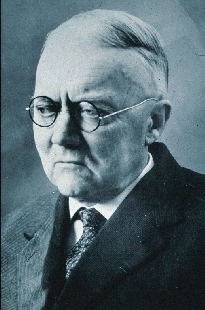
Fig. 3c. Ernst Julius Öpik (1893--1985), director in Tartu from 1921 to 1944 (Wikipedia, CC3, Martin Murphy, Armagh)
Fig. 3. Tartu Observatory (Photo: Gudrun Wolfschmidt)
Political Changes
- Dorpat (Tartu) under German leadership: 1810 to 1891
By 1900, all eight directors came from Germany. Worthy of special mention are Friedrich Georg Wilhelm Struve, his grandson Ludwig von Struve and Johann Heinrich Mädler, known for his moon chart.
- Derpt (until 1893), Jurjew (Tartu) under Russian leadership: 1894 to 1918:
From 1894 to 1918, there were Russian directors. - Tartu under Estonian leadership: 1919 to 1948
In 1919, Estonia became independent and Dorpat was renamed Tartu. Taavet Rootsmäe [Rootsman, David (until 1936)] (1885-1959) was the first Estonian director of the observatory, 1919 to 1948. - Jurjew (Tartu) under Russian leadership: 1948 to 1990:
In 1946, under Russian administration, the observatory was taken from the University of Tartu and given to the Estonian Academy of Sciences. The Institute of Physics, Mathematics and Mechanics at the Academy of Sciences of the Estonian S.S.R. was founded. - Tartu under Estonian leadership: since 1990
In 1963 a new observatory building was erected in Tõravere.
The observatory grew into the Institute of Physics and Astronomy; in 1974, it became the Institute of Astronomy and Atmospheric Physics.
In 1996, the old observatory was given back to the University of Tartu and was reconstructed in 2009/10 and now serves as a museum.
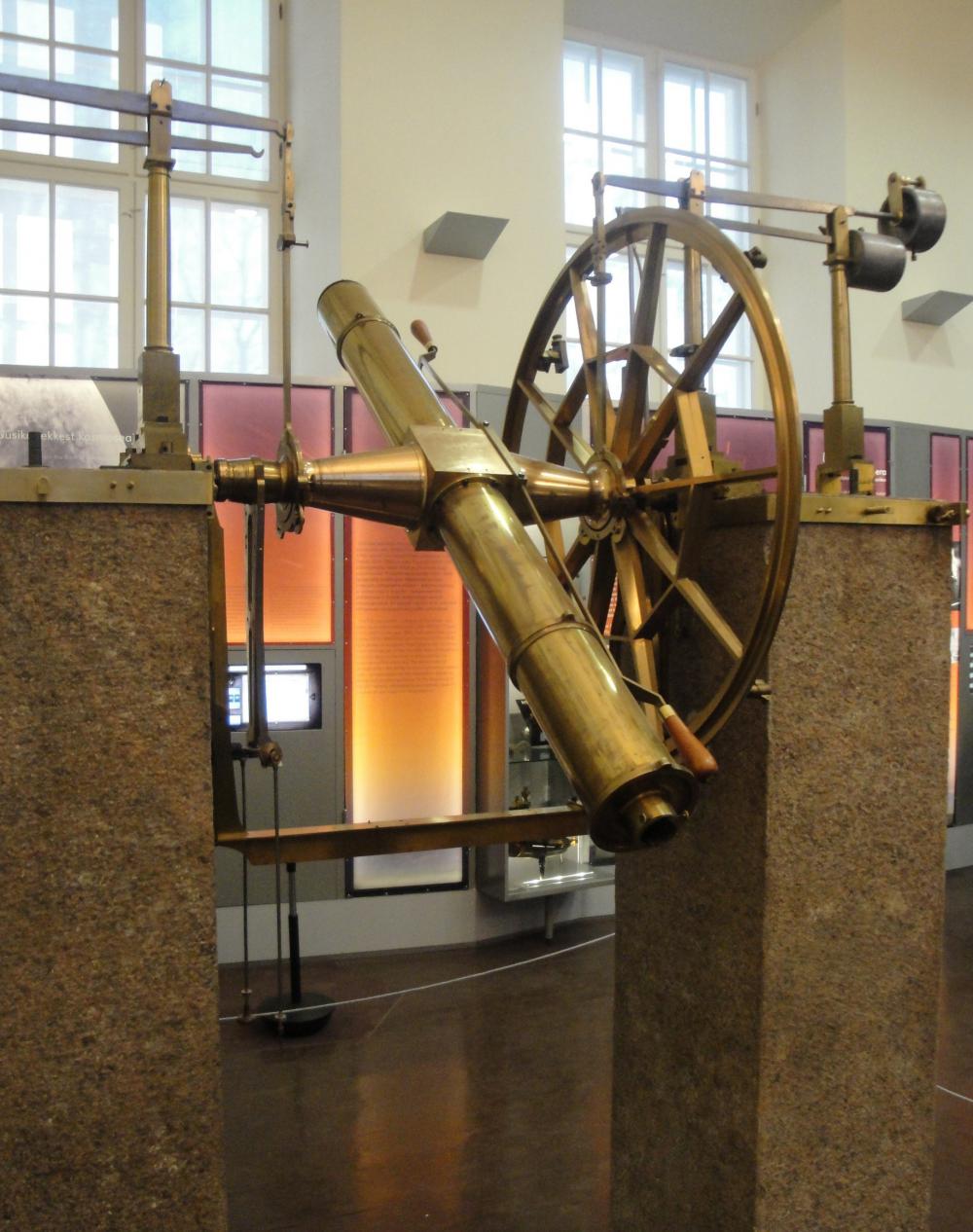
Fig. 4a. Meridian Circle, Reichenbach & Ertel of Munich (1822), Tartu Observatory (Photo: Gudrun Wolfschmidt)
Fig. 4b. 20-cm-refractor, Carl Zeiss of Jena (1911), Tartu Observatory (Photo: Gudrun Wolfschmidt)
Fig. 4c. The 24-cm-Fraunhofer refractor (1824) of Tartu Observatory (Photo: Gudrun Wolfschmidt)
Instruments
- 7 ft Newton Reflector, Friedrich Wilhelm Herschel (1738--1822), aperture 15.9cm, focal length 214cm
- Pendulum clock (sideral time), John & Myles Brockbanks (1761--1806, 1769--1821) with tubular compensation pendulum of different metals according to Troughton
- 8 ft Transit instrument, Dollond, aperture 4.5''
- small Transit instrument, Williams
- Repetition theodolit, Wilhelm Gottlob Benjamin
Baumann (1772--1849) of Stuttgart (1806) - Pendulum clock, Brockbanks
- 12 ft Reflector (aperture 12'', 26cm),
Johann Gottlieb Friedrich Schrader (1763--1832/33) of Kiel,
Anton Rospini of Petersburg (1820) - Reichenbach Meridian Circle (1822)
- 24-cm-Achromatic Refractor, Utzschneider & Fraunhofer of Munich (1824) with clock driven gearing for rotation around the axis
- Heliometer (aperture 108mm, focal length 165cm), A. Repsold & Söhne of Hamburg (1873)
- Zenith telescope, A. Repsold & Söhne of Hamburg (1897)
- 20-cm refractor, Carl Zeiss of Jena (1911), focal length of 3m
- Astrograph, Petzval (1911) with a 15-cm aperture and 78-cm focal length
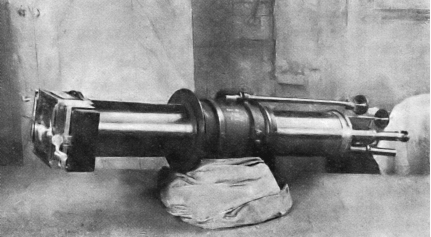
Fig. 4d. Heliometer (aperture 108mm, focal length 165cm), A. Repsold & Söhne of Hamburg (1873) (Tartu Observatory)
In 1873, a Repsold heliometer was acquired -- a telescope with a divided lens for measuring smallest angular differences -- and in 1897 a zenith telescope, made by A. Repsold & Söhne of Hamburg.
In 1911, a 20-cm refractor from Carl Zeiss with a focal length of 3-m was put into operation. In the same year, an astrograph made by Petzval with a 15-cm aperture and 78-cm focal length was installed to perform astrophotography.
State of preservation
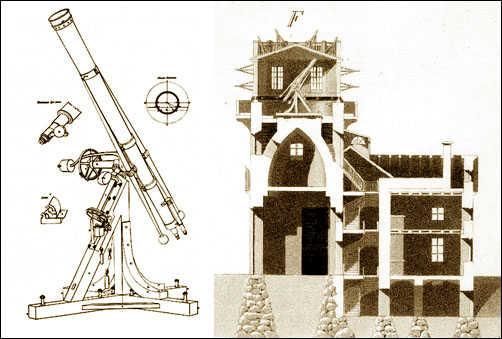
Fig. 5a. Mounting of the Fraunhofer Refractor (Pedro Ré, 2008)
Fig. 5b. Tartu Observatory (Photo: Gudrun Wolfschmidt, 2011)
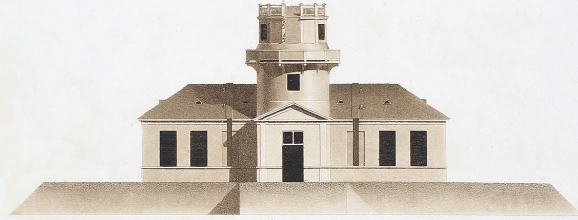
Fig. 5c. Tartu Observatory (credit: Tartu virtual)
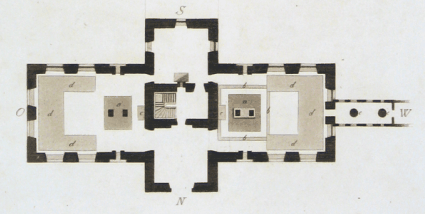
Fig. 5d. Layout of Tartu Observatory (credit: Tartu virtual)
In 1996, the historical observatory building was given back to the University of Tartu and now serves as a museum.
From 2009 to 2011, the observatory building was well restored, also the famous Fraunhofer Refractor.
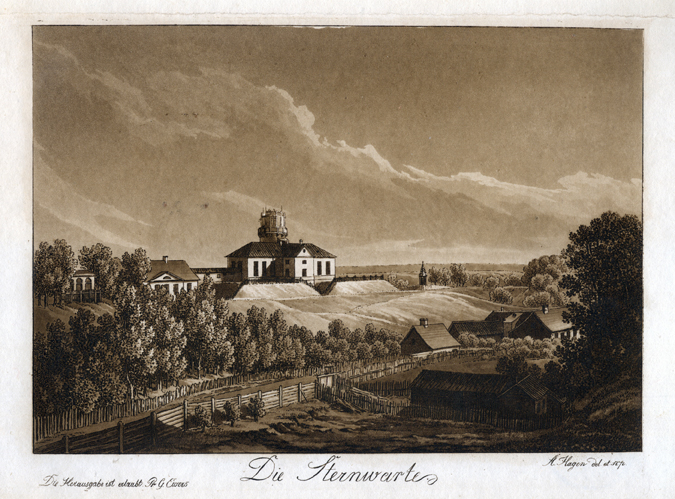
Fig. 5e. Tartu Observatory (Lithography August Matthias Hagen (1794--1878), 1827, Wikipedia)
Comparison with related/similar sites
Fig. 6. Dome of Tartu Observatory (Photo: Gudrun Wolfschmidt)
From the One to the Three Dome Observatory
As a typical architecture in the 19th century the rectangular observatory with a central dome was developed in addition to the cross-shaped complex. An important early example is the Tartu (Dorpat) observatory (Maegi 2009, p. 189--195) in Estonia (1810). Here, Fraunhofer’s innovative idea of introducing a clock drive for the equatorially mounted refractor in order to compensate the rotation of the earth.
The observatory on Vartiovuori Hill (1819) belonged to the Royal Academy of Turku (Åbo). The neoclassic building was designed by the German architect Carl Ludvig Engel (1778--1840), and his work also includes the observatory built later in Helsinki. During the Great Fire of Turku (1827) only the observatory and a few wooden houses were left, as Friedrich Wilhelm Argelander remarked on Sept. 4, 1827: "Hic observationes terribili illo interceptae sunt incendio, quod totam fere urbeam ad ineres reduxit, observatorium vero, gratiae habeantur Deo OM, salvum intactumque reliquit." (Here the observations were stopped by a terrible fire that burned the whole city, but, thank God, the observatory remained intact).
The Turku Academy moved the observatory and instruments to Helsinki a few years later. In 1836 the Åbo Navigationsskola (Swedish Navigation School) was moved into the empty building and stayed there until 1967; in 1998 it became a maritime and astronomical museum.
Comparable observatory buildings of the early 19th century: Naples (1820), Warsaw (1820--1824), Cape Town (1828), Christiania/Oslo (1831), Helsinki/Helsingborg (1834) and Berlin, New Observatory (1835, demolished 1915).
Threats or potential threats
no threats
Present use
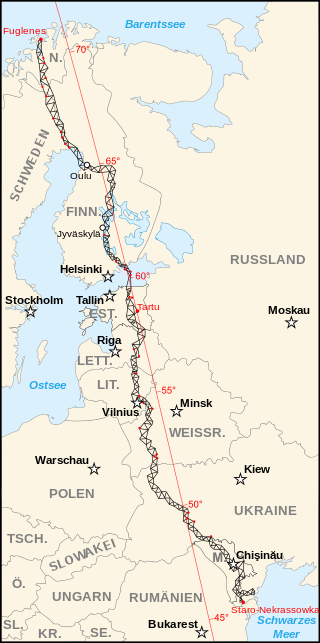
Fig. 7. Struve Geodetic Arc (UNESCO)
Today the University of Tartu -- Old Observatory (Tartu Tähetorn) houses an astromical museum, public observatory with a visitor center.
Tartu Observarory is part of Struve Geodetic Arc (UNESCO, 1187), 2005.
Astronomical relevance today
The old observatory is since 1963 no longer used for modern astronomical research.
See: new Tartu observatory: Tartu Ülikool, Observatooriumi 1, Töravere, 61602 Tartumaa
Instruments
- 50cm reflector telescope (1963)
- 1.5-m-Cassegrain telescope (AZT-12) (1974)
- 0.6-m-Reflecting telescope (Zeiss 600) (1998)
- 0.31-m-Reflecting robotic telescope (RAITS) (2013)
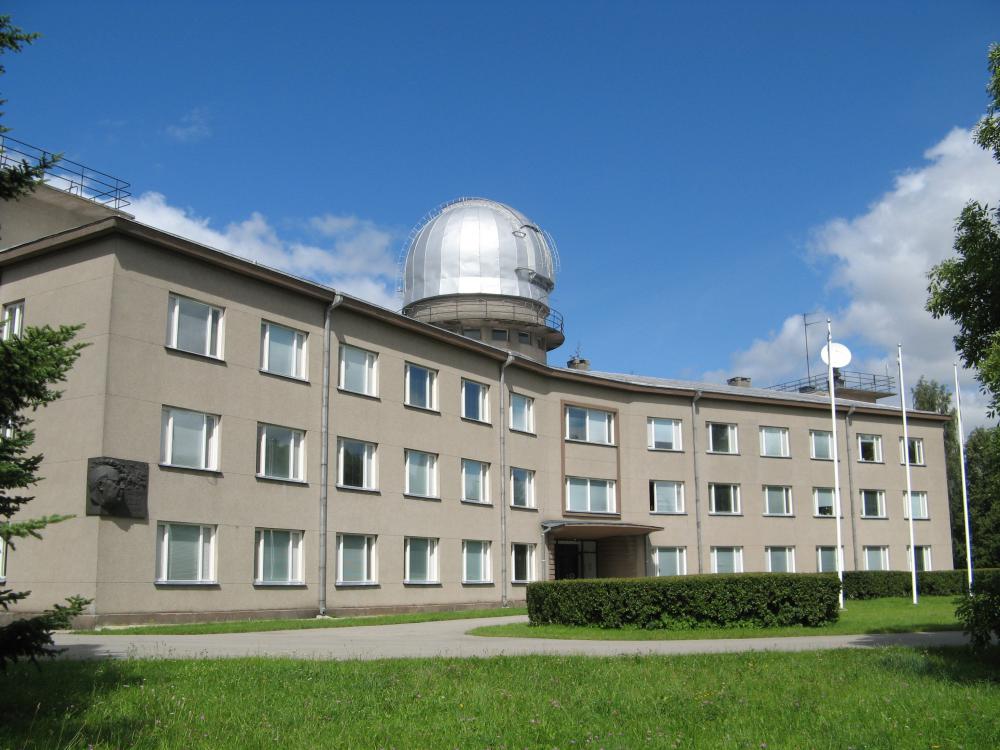
Fig. 8a. New observatory in Töravere (*1963)
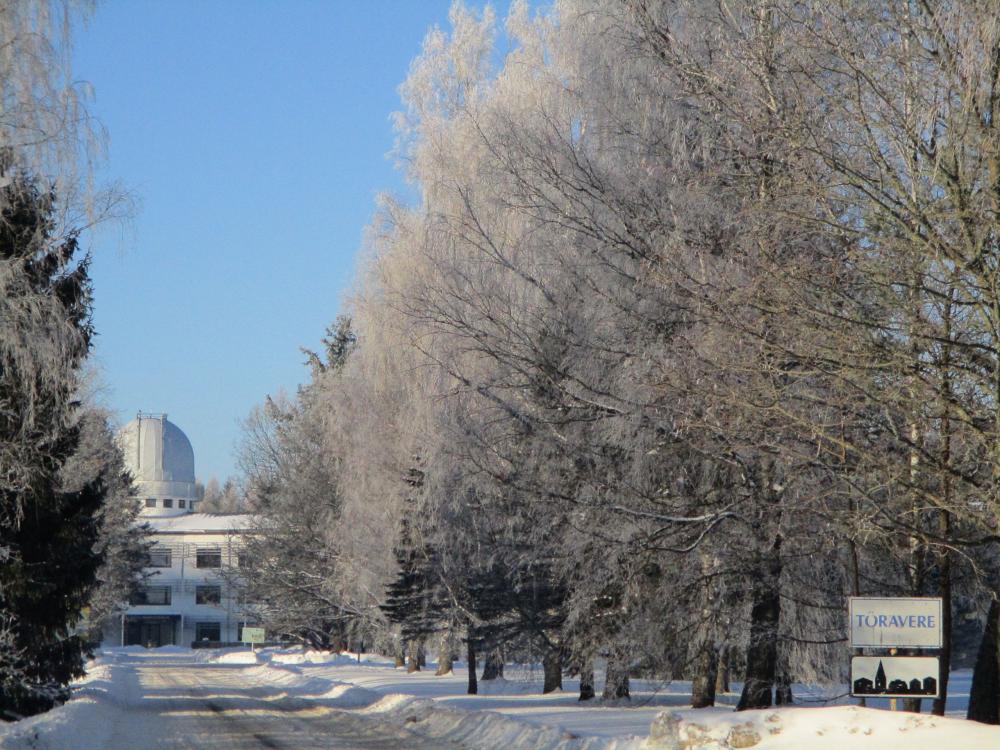
Fig. 8b. New observatory in Töravere (*1963) (Photo: Tönu Viik)
References
Bibliography (books and published articles)
- Batten, Alan Henry: Resolute and Undertaking Characters: the lives of Wilhelm and Otto Struve. Dordrecht, Boston: D. Reidel Pub. (Astrophysics and Space Science Library, Bd. 139) 1988.
- Eelsalu, Heino: An Attempt to draw up a List of Instruments acquired by Tartu Observatory before 1825. In: Rara Cosmographica in Estonia, Supplementum (= W. Struve nimeline Tartu Astrofüüsika Observatoorium, Teated Nr. 69), Tartu 1983, S. 8--17.
- Eelsalu, Heino & Dieter B. Herrmann: Johann Heinrich Mädler (1794--1874) - Eine dokumentarische Biographie. Berlin: Akademie-Verlag 1985.
- Eelsalu, Heino & H. Raudsaar: The List of Instruments and Related Objects kept in the Tartu Observatory Museum. In: Archivalia uranographica. Tartu (W. Struve nimeline Tartu Astrofüüsika Observatoorium, Teated Nr. 93) 1989, p. 4-15.
- Lenz, Wilhelm (Hg.). Deutschbaltisches biographisches Lexikon 1710--1960. Köln, Wien: Böhlau 1970.
- Leppik, Lea: Observatory of Tartu/Dorpat as the leading observatory in Russian Empire. In: Wolfschmidt 2018, p. 266--299.
- Leue, Hans-Joachim: Johann Gottlieb Schrader und der Lilienthaler Fernrohrbau. In: Dick, Wolfgang R. & Jürgen Hamel (ed.): Astronomie von Olbers bis Schwarzschild: Nationale Entwicklungen und internationale Beziehungen im 19. Jahrhundert. Frankfurt am Main (Acta Historica Astronomiae, Bd. 14) 2002, p. 37--50.
- Levitzky, Grigori: Astronomy Yur’evskago universiteta s 1802 po 1894 god [Die Astronomen der Jurjewer Universität von 1802 bis 1894]. Jurjew [Dorpat, Tartu] 1899.
- Maegi, Reet: The Heritage of the 200-Year-Old University Observatory in Tartu. In: Wolfschmidt 2009, S.~188--195.
- Müürseep, Peeter: Gauss and Tartu University. In: Historia Mathematica 5 (1978), p. 455-459.
- Oestmann, Günther: J.W.A. Pfaff and the Rediscovery of Astrology in the Age of Romanticism. In: Oestmann, Günther: H. Darrel Rutkin & Kocku von Stuckrad (ed.): Horoscopes and Public Spheres: Essays on the History of Astrology. Berlin, New York (Religion and Society, Bd. 42) 2005, p. 241-257.
- Oestmann, Günther: Zur frühen Geschichte der Dorpater Sternwarte und ihrer instrumentellen Ausstattung. In: Hamel, Jürgen & Inge Keil (Hg.): Der Meister und die Fernrohre: Das Wechselspiel zwischen Astronomie und Optik in der Geschichte. Festschrift zum 85. Geburtstag von Rolf Riekher. Frankfurt am Main (Acta Historica Astronomiae, Bd. 33) 2007, p. 315--331.
- Pfaff, Johann Wilhelm Andreas: Astronomische Beobachtungen, vom Hrn. Prof. Pfaff aus Dorpat, unt. 20. Oct. 1807 eingesandt. In: Bode, Johann Elert (Hg.): Sammlung astronomischer Abhandlungen, Beobachtungen und Nachrichten. Berlin (Astronomisches Jahrbuch, Supplementband 4) 1808, S. 231-232.
- Raudsepp, Marje: Wilhelm Struves Reisebericht aus dem Jahre 1820 betreffend die damalige astronomische Instrumentenkunde. In: Archivalia cosmographica (W. Struve nimeline Tartu Astrofüüsika Observatoorium, Teated, Nr. 88). Tartu 1987, S. 6-16.
- Riekher, Rolf: Fernrohre und ihre Meister. Berlin: Verlag Technik GmbH 1957, (2nd edition) 1990.
- Struve, Friedrich Georg Wilhelm: De geographica positione speculae astronomicae Dorpatensis. Mitau 1813.
- Waaland, J. Robert: Fraunhofer and the Great Dorpat Refractor. In: American Journal of Physics 35 (1967), Issue 4, p. 344--350.
- Wolfschmidt, Gudrun (ed.): Astronomie im Ostseeraum - Astronomy in the Baltic. Hamburg: tredition (Nuncius Hamburgensis; Band 38) 2018.
- Wolfschmidt, Gudrun (ed.): Cultural Heritage of Astronomical Observatories -- From Classical Astronomy to Modern Astrophysics. Proceedings of International ICOMOS Symposium in Hamburg, October 14--17, 2008. Berlin: hendrik Bäßler-Verlag (International Council on Monuments and Sites, Monuments and Sites XVIII) 2009.
- Zhelnin, Georgi: History of the Tartu Observatory (1805--1948). Tartu 2020. Translated by T├Ánu Viik from: Tartu Observatoorium 1805--1948. Tartu Observatooriumi Virtuaalne Muuseum 2004.
Links to external sites
No multimedia content published
Currently there is no multimedia content published for this case study






